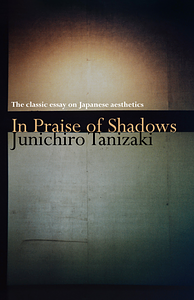Take a photo of a barcode or cover
reflective
fast-paced
Nice enough, but no desire to keep reading
This is a hard book to categorize. Tanizaki covers a wide range of subjects, moods, experiences. The great tie-in is simply shadow. Tanizaki expounds on the beauty and depth of shadows to an extent quite worthy of the essay's title. I especially appreciated his observation that beauty is distilled from daily life: we will find beautiful, and make beautiful, that which fits in with our environment and lifestyle.
4.5 one of the most interesting things I have read in a long time. Reflections by a Japanese author for the Japanese preference for things in the shadows, items that look better when see in the dark, and the interplay of culture and aesthetics. Contrasts with American preferences for light and shiny things. Explains why certain preferences may have developed with a focus on architecture and the arts…he also looks at what Japanese people have done in order to have their skin look as white as possible and has a western centric view of whiteness and the cultural view of the desirability of porcelain skin. Race is a small part of the discussion. But he thinks a lot about shadows and the Japanese style of shadows and darkness compared to western taste.
informative
reflective
medium-paced
- This really gets into the Japanese psyche of romanticizing every little thing.
- Tanizaki is such a hater. Though I felt many of his complaints were abilist (romanticizing having a separate outhouse), classicist (his severe preference of Noh theater as superior to Kabuki), sexist (colorism), and complaints about electricity (what a first world problem!).
- His thesis on the lessening of shadows as a metaphor for the doing away with the past for the modern is just about what every Japanese piece of art is about (which is interesting).
- It was a lot funnier than I thought it would be.
- Tanizaki is such a hater. Though I felt many of his complaints were abilist (romanticizing having a separate outhouse), classicist (his severe preference of Noh theater as superior to Kabuki), sexist (colorism), and complaints about electricity (what a first world problem!).
- His thesis on the lessening of shadows as a metaphor for the doing away with the past for the modern is just about what every Japanese piece of art is about (which is interesting).
- It was a lot funnier than I thought it would be.
inspiring
reflective
challenging
informative
inspiring
reflective
relaxing
slow-paced
funny
informative
reflective
slow-paced
this was much funnier than i was expecting! and an excellent translation, the author’s voice is clearly evident. it was an interesting mediation on Japanese aesthetics and sensibilities from a man who was clearly very sensitive to his surroundings and lived in a time of great cultural shifts in Japan. Tanizaki writes of remembering a time before electric lights and Western dress, and as a result feels deeply the incongruity that Western technology and influence placed on a Japan suddenly thrust into it. things i consider so mundane are viewed completely differently from such a perspective, and i love the detail with which Tanizaki can pontificate on the minutiae of everyday items and aesthetics. that’s the kind of melodramatic artistic romanticism that i live for. i wish i had a trip to Japan upcoming, just so that i could put Tanizaki’s reflections into practice myself.
funny
lighthearted
reflective
fast-paced
An enjoyable, meandering essay that moves seamlessly from reflections on toilets to the glow of candlelight in restaurants. I found myself racing through it, thinking about why we fill our homes with light and what we might gain from embracing depth and shadow in our spaces.
While it explores interiors and tradition, it also offers insight into shifting aesthetics in both Japan and the West—how they evolve, influence one another, and shape the way we experience the world. As a Western reader, I found the author’s thoughts on Japanese culture and theater particularly interesting. Some might find the structure a bit scattered, but that wandering quality is part of its charm.
That said, one moment in the afterword stood out to me—an architect, convinced he understood the author’s vision after reading this essay, confidently stated, “I know exactly what you want.” To which the author replied, “But no, I could never live in a house like that.” It’s a reminder that these are musings, not a rigid philosophy—thoughts to consider rather than a final verdict on how things should be.
While it explores interiors and tradition, it also offers insight into shifting aesthetics in both Japan and the West—how they evolve, influence one another, and shape the way we experience the world. As a Western reader, I found the author’s thoughts on Japanese culture and theater particularly interesting. Some might find the structure a bit scattered, but that wandering quality is part of its charm.
That said, one moment in the afterword stood out to me—an architect, convinced he understood the author’s vision after reading this essay, confidently stated, “I know exactly what you want.” To which the author replied, “But no, I could never live in a house like that.” It’s a reminder that these are musings, not a rigid philosophy—thoughts to consider rather than a final verdict on how things should be.





